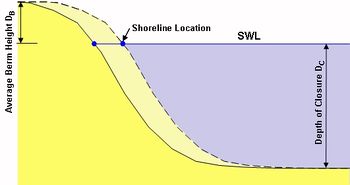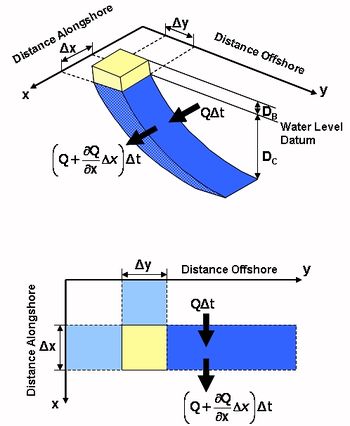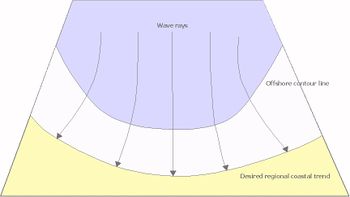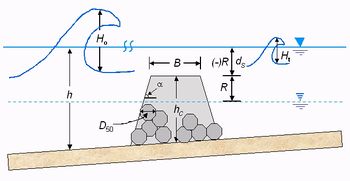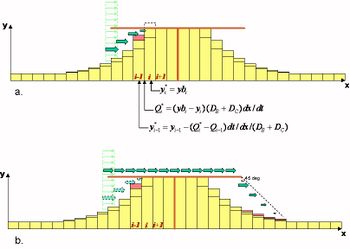Littoral drift and shoreline modelling
Littoral drift, the wave-driven longshore transport of sediment, plays a major role in shoreline dynamics. Human-induced modification of littoral drift is a ubiquitous cause of coastal erosion (see Human causes of coastal erosion). Measuring littoral drift in field situations is notoriously difficult and generally subject to great uncertainty. Therefore, model estimates are often used in practice. A simple, popular model is the so-called 1-line model, derived from shallow-water wave theory. In this article a generalized version of this model (called GENESIS [1]) is presented, together with conditions and prescriptions for practical application.
Contents
The One-Line Concept
The 1-line concept rests on a common observation that the beach profile maintains an average shape that is characteristic of the particular coast, apart from times of extreme change as produced by storms. For example, steep beaches remain steep and gently sloping beaches remain gentle in a comparative sense and in the long term. Although seasonal changes in wave climate cause the position of the shoreline to move shoreward and seaward in a cyclical manner, with corresponding change in shape and average slope of the profile, the deviation from an average beach slope over the total active profile is relatively small. Pelnard-Considere (1956)[2] originated a mathematical theory of shoreline response to wave action under the assumption that the beach profile moves parallel to itself, i.e., that it translates shoreward and seaward without changing shape in the course of eroding and accreting. If the profile shape does not change, any point on it is sufficient to specify the location of the entire profile with respect to a baseline (Fig. 1). Thus, one contour line can be used to describe change in the beach plan shape and volume as the beach erodes and accretes. This contour line is conveniently taken as the readily observed shoreline, and the model is therefore called the "shoreline change" or "shoreline response" model. Sometimes the terminology "one-line" model, a shortening of the phrase "one-contour line" model is used with reference to the single contour line.
[math] \frac{\Delta y}{\Delta t} + \frac{1}{(D_B + D_C)} \frac{\Delta Q}{\Delta x} = 0 \qquad (1) [/math]
The model also requires predictive expressions for the total longshore sand transport rate. For open-coast beaches, the transport rate is a function of the breaking wave height and direction alongshore. The predictive formula for the longshore sand transport rate used in GENESIS is (see Shallow-water wave theory for a derivation):
[math] Q = (H^2 C_g)_b (a_1 \sin {2 \alpha_{bs}} + a_2 \cos {\alpha_{bs}} \frac {\partial H}{\partial x}) \qquad (2) [/math]
in which H = wave height, Cg = wave group speed given by linear wave theory, b = subscript denoting wave breaking condition, and αbs = angle of breaking waves to the local shoreline.
The nondimensional parameters a1 and a1 are given by
[math] a_1 = \frac {K_1}{16 (s - 1)(1 - p)W} \qquad (3a) [/math]
and
[math] a_1 = \frac {K_2}{8 (s - 1)(1 - p)W \tan \beta} \qquad (3b) [/math]
Representation of Currents
By writing the transport rate in terms of immersed weight, Il (N/s), Eqs. (1) and (2) may be expressed as,
[math] I_l = (E C_g)_b (K_1 \sin { \alpha_{b}} \cos {\alpha_{b}} - K_2 \frac { \cos {\alpha_{b}}}{ \tan {\beta}} \frac {\partial H}{\partial x}) \qquad (4) [/math]
where E is the wave energy density (J/m2). The classical ‘CERC’-equation for calculating the longshore sediment transport rate is formulated as,
[math] I_l = (E C_g)_b K_1 \sin { \alpha_{b}} \cos {\alpha_{b}} \qquad (5) [/math]
which is identical to the first term in the GENESIS transport relation as given in Eq. (2). Following the formula proposed by Bagnold (1963)[3], Eq. (5) can be modified to explicitly represent a longshore current as,
[math] I_l = K_3 (E C_g)_b \cos {\alpha_{b}} \frac{v_l}{u_m} \qquad (6) [/math]
where K3 is a dimensionless coefficient, vl is the average longshore current in the surf zone, and um is the maximum wave-induced near-bottom horizontal velocity at wave breaking which may be written as,
[math] u_m = ( \frac {2 E_b} {\rho h_b} )^{1/2} = ( \frac {\gamma g H_b} {4 * 1.416} )^{1/2} \qquad (7) [/math]
where hb is the breaker depth, γ is the breaker index, and g is the acceleration due to gravity. By using Eq. (6), the longshore sediment transport rate is no longer restricted to being generated exclusively by breaking waves; the longshore current may originate from other mechanisms as discussed further by Komar and Inman (1970)[4] and Kraus et al. (1982)[5], for example, as generated by the tide or the wind.
Thus, by assuming shallow water conditions at the location of wave breaking, the wave group velocity Cgb may be approximated,
[math] C_{gb} ~ C_b ~ \sqrt {g h_b} \sqrt { g H_b / \gamma} \qquad (8) [/math]
where Cb is the wave breaking celerity. Inserting Eq. (7) into Eq. (6) yields
[math] I_l = \frac {K_3}{4 * 1.416^2} ( g / \gamma )^{1/2} \rho H_b^{1.5} C_g v_l \alpha_{bs} \qquad (9) [/math]
If the longshore current vl comprise of a wave generated current vb alone, it may be calculated as (Lonquet-Higgins 1970[6], see also Shallow-water wave theory)
[math] v_l = v_b = K_4 u_m \sin \alpha_b \qquad (10) [/math]
where K4 is an empirical coefficient for which Komar and Inman (1970)[4] suggested K4 = 2.7. By combining Eqs. (5), (6), and (10) we obtain K3 = K1/K4 = 0.28. Thus, with only wave generated currents taken into account, Eqs (6) and (10) together are compatible with the ‘CERC’ equation but are still able to account for currents of different origin.
Along the same lines, Hanson et al. (2001)[7] proposed a generalized version of Eq. (9) which includes the effect of longshore gradients as,
[math] v_b = K_4 u_m \sin \alpha_b - K_5 \frac {4}{ \gamma g} u_m \frac {\partial u_m^2}{\partial x} \frac {1}{ \tan \beta} \qquad (11) [/math]
where K5 is an empirical coefficient (= K2/K3). It can easily be shown that Eq. (11) inserted into Eq. (6) reduces back to Eq. (4). Thus, the proposed relationship expressed in Eq. (11) is equivalent to the ‘original’ transport relationship used in GENESIS with only wave-generated transport accounted for.
Representation of Offshore Contours
If a 2D external wave transformation model is not used in the present Corps of Engineers version of GENESIS, the offshore contour orientation, upon which the incoming waves are refracted, is calculated as a smoothed rendering of the shoreline orientation. This is to assure that the incident waves are realistic while preserving some feedback from the shoreline change to a change in the transformation of the waves (Kraus and Harikai 1983 [8]). However, this methodology has two limitations: 1) dominant local or regional bathymetric features are not well represented, and 2) an open coast without structures or sources or sinks of sediment will evolve to a straight line if the model is run a sufficiently long time. These limitations can be remedied by specifying a fixed representative or effective contour (Hanson and Kraus 1993[9]) which is appended to the feed-back contour associated with local changes in the shoreline (Fig. 4). Correctly specified, the waves transformed over this contour within the GENESIS will maintain a desired overall shoreline curvature, e.g. preserving a bay shape without the presence of structures, even if the model is run for very long time periods.Representation of Variable Transmission Coefficient for Submerged Breakwaters
The transmission coefficient is a leading parameter in controlling beach response to detached breakwaters (Hanson and Kraus 1990[10]). Previously the GENESIS model only represented a constant transmission coefficient (Kt = Ht / Ho in Fig. 5) for detached breakwaters. To improve the predictive capability of the GENESIS model, several published empirical formulae for the wave transmission coefficient were evaluated. In the revised GENESIS, the user may choose either a constant value of Kt for each structure or allow the model to calculate appropriate values based on time-varying water level and wave height, and structure characteristics. If the variable-Kt option is selected, water level is read from an input file at a specified input time interval. For each structure, the user specifies geometric properties (crest height and width, slopes on seaward and landward sides, and median rock size) and can select between the calculation methods of Ahrens (2001)[11], Seabrook and Hall (1998)[12], and d'Angremond et al. (1996)[13]. The method selected should be based upon structure type and configuration.Based on the input values describing the structure, water level, and calculated wave properties, a corresponding Kt is calculated for each structure at each time step. The calculated Kt will have a strong influence on the wave field behind and adjacent to the structure as it influences wave transmission and diffraction. Through an iterative procedure for calculating wave breaking, Kt also influences the breaking wave height and direction alongshore, thereby determining the associated shoreline response to the structure (Hanson and Kraus 1989[1], 1990 [10], 1991a[14], 1991b[15]).
Representation of Tombolos
The boundary condition for representing tombolo formation at T-head groynes and detached breakwaters (DBWs) is formulated analogously to that of a seawall in GENESIS as discussed in Hanson and Kraus (1985)[16]. However, implementation of the tombolo constraint is more complex as it includes wave diffraction, blocking of previously open calculation cells, and transport of sediment on both the landward and the seaward sides of the structure. The tombolo concept implies that the beach can reach the structure but not further. As a calculation cell makes contact with the structure, the transport rate into that cell is adjusted to allow the excess sediment to remain in updrift cells. The procedure to do this must conserve sediment volume and preserve the direction of its transport.The procedure is illustrated in Fig. 6, a plan view of an idealized beach protected by a DBW at an arbitrary moment in time. A tombolo has developed in Cell i+1 in a previous time step. In the adjacent Cell i, allowing the calculated influx Qi from Cell i-1 to enter, the shoreline would advance beyond the DBW (Fig. 6a), which is not allowed.
Thus, the initially calculated transport rate Q6 must be adjusted to Q6* (Fig. 6b) to cause the shoreline to advance up to the detached breakwater but no further, giving y6* = yt. With the new transport now going out of Cell 5, the shoreline location in this cell will be adjusted from y5 to y5*. In this particular case, only two cells were recalculated. In the general case, the correction may be carried through any number of cells until the criterion that the shoreline may not advance beyond the DBW is not violated.
Related articles
Modelling Review (all generic types) V.Magar, J.Sutherland, H.Hanson
How to apply models I. Broker
Process-based Morphological Models – Applications to longer Time Frame I. Broker
Stability Models: Linear and nonlinear A. Falques Serra
Shallow-water wave theory A. Chadwick
Human causes of coastal erosion K. Mangor
Coastal Hydrodynamics And Transport Processes K. Mangor
Typical examples of structural erosion J. van de Graaff
Dealing with coastal erosion J. van de Graaff
Accretion and erosion for different coastal types K. Mangor
Port breakwaters and coastal erosion M. Belorgey
References.
- ↑ 1.0 1.1 Hanson, H., and Kraus, N. C. 1989. "GENESIS: Generalized model for simulating shoreline change, Report 1: Technical Reference." Tech. Rep. CERC-89-19, U.S. Army Engineer Waterways Experiment Station, Coastal Engineering Research Center, Vicksburg, MS.
- ↑ Pelnard-Considere, R. 1956. “Essai de Theorie de l’Evolutio des Form de Rivage en Plage de Sable et de Galets,” 4th Journees de l’Hydaulique, Les Energies de la Mer, Question III, No. 1, 289-298.
- ↑ Bagnold, R.A. 1963. Mechanics of Marine Sedimentation, in The Sea, Vol. 3, 507-528, (ed. Hill, M.N.), Interscience, NY.
- ↑ 4.0 4.1 Komar, P.D. and Inman, D.L. 1970. Longshore sand transport on beaches, J. Geoph. Res., 75(30), 5914-5927.
- ↑ Kraus, N.C., Isobe, M., Igarashi, H., Sasaki, T. and Horikawa, K. 1982. Field Experiments on Longshore Sand Transport in the Surf Zone, Proceedings 18th Coastal Engineering Conference, ASCE, 969-988.
- ↑ Longuet-Higgins, M.S. 1970. Longshore Currents Generated by Obliquely Incident Sea Waves, 1, Journal of Geophysical Research, 75(33), 6778-6789.
- ↑ Hanson, H., Larson, M., and Kraus, N.C. 2001. “A New Approach to Represent Tidal Currents and Bathymetric Features in the One-Line Model Concept,” Proc. Coastal Dynamics '01, ASCE, 172-181.
- ↑ Kraus, N.C., and Harikai, S. 1983. Numerical Model of the Shoreline Change at Oarai Beach. Coastal Engineering, 7(1), 1-28.
- ↑ Hanson, H. and Kraus, N.C. 1993. "Optimization of Beach Fill Transitions," in "Beach Nourishment Engineering and Management Considerations," Stauble, D.K. and Kraus, N.C. (Vol.Eds.), Proc. Coastal Zone '93, ASCE, 103-117.
- ↑ 10.0 10.1 Hanson, H., and Kraus, N. C. 1990. "Shoreline response to a single transmissive detached breakwater." Proceedings 22nd Coastal Engineering Conference, ASCE, 2034-2046.
- ↑ Ahrens, J. P. 2001. "Wave transmission over and through rubble-mound breakwaters." Draft Contract Report submitted to the U.S. Army Engineer Research and Development Center., Coastal and Hydraulics Laboratory, Vicksburg, MS.
- ↑ Seabrook, S., and Hall, K. 1998. "Wave transmission at submerged rubble mound breakwaters." Proceedings 26th Coastal Engineering Conference, ASCE, 2000- 2013.
- ↑ d'Angremond, K., van der Meer, J., and De Jong, R. 1996. "Wave transmission at low-crested structures." Proceedings 25th Coastal Engineering Conference, ASCE, 2418-2427.
- ↑ Hanson, H., and Kraus, N. C. 1991a. “Numerical simulation of shoreline change at Lorain, Ohio,” J. Waterway, Port, Coastal and Ocean Engineering, 117(1), 1-18.
- ↑ Hanson, H., and Kraus, N. C. 1991b. "Comparison of shoreline change obtained with physical and numerical models," Proceedings Coastal Sediments '91, ASCE, 1785-1813.
- ↑ Hanson, H. and Kraus, N.C. 1985. "Seawall Constraint in the Shoreline Numerical Model," Journal of Waterway, Port, Coastal and Ocean Eng., ASCE, Vol. 111, No. 6, 1079 1083.
Please note that others may also have edited the contents of this article.
|
